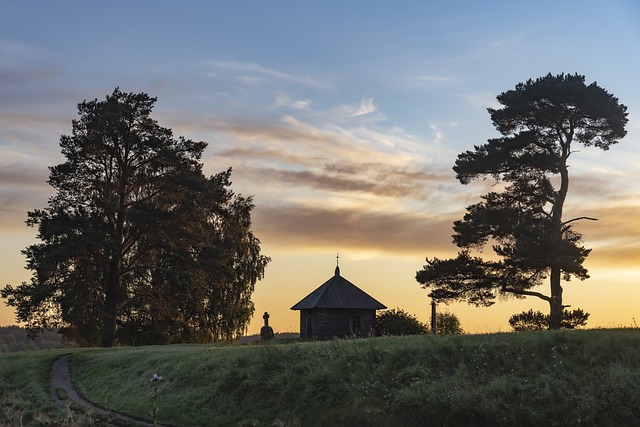In densely populated cities where space is scarce, innovative landscaping transforms tiny balconies and rooftop terraces into verdant retreats through vertical gardens and climbers like ivy or clematis. These spaces become richly layered green havens that are both visually appealing and practical, enhanced by the use of mirrors to amplify their natural beauty and perceived size. Urban gardening benefits from modular planters and raised beds, which are adaptable to any space's unique dimensions and conserve water with smart irrigation systems, ensuring lush greenery with minimal upkeep. Careful plant selection is key for year-round aesthetic appeal, with low-maintenance varieties that still deliver visual impact. For those with even the smallest spaces, vertical elements like trellises or pergolas combined with edible plants can create privacy and visual intrigue, while raised beds and container gardening optimize space for a diverse, personalized garden design. Kitchen gardens in compact settings advocate for integrating climbing edibles like tomatoes and pole beans alongside ornamental plants for dual purposes of beauty and food production. Strategic storage solutions and multifunctional pieces, such as seating with hidden storage, keep the garden both organized and attractive. Lastly, microgreens cultivation is presented as a sustainable and practical option for small-space landscaping, offering aesthetic appeal, culinary value, and environmental benefits, making them an ideal choice for urban green spaces.
Embark on a verdant journey through the realm of small space gardens, where creativity meets practicality. In this comprehensive guide, we explore innovative landscaping techniques designed for urban dwellers with limited outdoor real estate. From maximizing your vertical space to crafting an edible garden that’s both beautiful and functional, our article provides tailored solutions for efficient maintenance and sustainable options like microgreens. Transform your modest area into a thriving landscape with our expert advice on smart storage and design, ensuring every square inch is put to vibrant use.
- Maximizing Your Urban Oasis: Innovative Small Space Landscaping Techniques
- Vertical Vistas: Designing Compact Gardens with Height and Color
- Edible Elegance: Integrating an Ornamental and Functional Kitchen Garden in Tiny Spaces
- Smart Storage Solutions for Efficient Small Space Landscape Maintenance
- Harnessing the Power of Microgreens: A Sustainable Option for Limited Landscaping Areas
Maximizing Your Urban Oasis: Innovative Small Space Landscaping Techniques

In urban environments where space is at a premium, innovative landscaping techniques transform narrow balconies and rooftop terraces into lush oases. Utilizing vertical gardens and climbing plants like ivy or clematis can maximize limited areas, creating a multi-dimensional landscape that adds both beauty and functionality. Strategic placement of mirrors or reflective surfaces can also amplify light and visual space, making smaller gardens appear more expansive while showcasing the greenery effectively.
To further optimize your urban garden, consider the use of modular planters and raised beds, which allow for flexible design and easier maintenance. These can be stacked or arranged to fit the unique contours of your space, ensuring that every inch is utilized to its fullest potential. Smart irrigation systems, such as drip irrigation or self-watering containers, conserve water while keeping plants thriving with minimal effort. By combining these techniques with a thoughtful selection of low-maintenance yet visually impactful plants, even the smallest garden can become a vibrant extension of your living space.
Vertical Vistas: Designing Compact Gardens with Height and Color

When space is at a premium, leveraging vertical landscaping can transform a small garden into a vibrant display of greenery and color. Strategic placement of climbing plants such as ivies or clematis against a wall can create a lush backdrop that adds both privacy and visual interest. Utilizing trellises, obelisks, or pergolas to support these vertical gardens not only maximizes space but also introduces an element of height that can make a small garden appear more expansive. The choice of plants should consider the available sunlight and moisture levels, ensuring a thriving landscape all year round. Incorporating a variety of textures, heights, and colors in your vertical garden design can create a dynamic landscape that is both functional and aesthetically pleasing, making every inch of the space count.
To truly maximize the potential of small space gardens, consider integrating raised beds or container gardening into your vertical landscaping plan. These solutions not only save ground space but also offer control over soil composition and drainage, which can be crucial for certain plants. Raised beds can be constructed to fit narrow spaces or corners, allowing for a diverse selection of edibles or ornamentals. Containers, whether hanging baskets or stacked pots, add another layer of versatility to small space gardening, enabling gardeners to experiment with different plant combinations and achieve a personalized landscape that stands out in both design and function.
Edible Elegance: Integrating an Ornamental and Functional Kitchen Garden in Tiny Spaces

In compact urban settings or modest backyards, integrating a kitchen garden that marries aesthetics with functionality is a delightful solution for those who aspire to grow their own herbs and vegetables while maintaining a visually pleasing landscape. Strategic landscaping can transform even the smallest of spaces into a productive culinary oasis. Utilize vertical space by installing trellises or wall-mounted planters that allow climbing plants like tomatoes, cucumbers, or pole beans to ascend gracefully, maximizing the area while keeping the garden’s design harmonious with the surrounding environment. Interspersing these edible plants with ornamental companions such as marigolds not only adds a pop of color but also serves as a natural pest deterrent, creating a symbiotic relationship within the limited landscape.
When considering the layout of your kitchen garden, think beyond traditional rows and explore circular or square foot gardening methods that optimize space and accessibility. These designs can easily blend into the decorative elements of your outdoor area, such as stone borders or raised beds that double as seating or planters. By selecting edible plants with varying heights and textures, you can achieve a landscape that is both visually appealing and bountiful. This thoughtful integration of form and function ensures that even in the smallest of spaces, your garden can be both a feast for the eyes and a source of delicious, homegrown produce.
Smart Storage Solutions for Efficient Small Space Landscape Maintenance

In small space gardens, efficient maintenance hinges on smart storage solutions that maximize the use of limited space while keeping tools and supplies readily accessible. Investing in stackable bins or wall-mounted organizers can significantly declutter your outdoor area by storing gardening essentials vertically rather than horizontally, thus optimizing valuable floor space. Utilizing overhead storage options like hooks or shelves installed on garden shed walls can also keep frequently used tools within easy reach yet out of the way when not in use. Additionally, considering modular and collapsible options for larger items like wheelbarrows or compost bins can ensure that these landscaping aids do not become space-consuming obstacles in your small garden.
To further enhance the efficiency of small space garden maintenance, consider incorporating multifunctional pieces into your storage solutions. For instance, benches with built-in storage can offer seating while concealing gardening tools and supplies. Similarly, integrating planters with compartments for storing smaller landscaping items not only adds a decorative touch but also keeps your garden looking tidy and organized. These thoughtful additions transform every square foot of your garden into a space that serves both aesthetic and functional purposes, ensuring that the focus remains on the beauty of the landscape rather than the clutter.
Harnessing the Power of Microgreens: A Sustainable Option for Limited Landscaping Areas

In urban and limited-space environments, the cultivation of microgreens emerges as an innovative and sustainable solution for those interested in landscaping with a small footprint. These nutrient-dense greens not only add a splash of vibrant color to any landscape but also offer a yield that is both high and rapid, making them ideal for compact spaces where traditional gardening might be impractical. Microgreens require minimal space, as they can be grown in containers or even windowsills, thus allowing city dwellers to participate in the joys of gardening despite constraints on outdoor area. Furthermore, these greens are not only a visual delight but also a culinary treasure, providing fresh produce that can enhance meals and contribute to a healthier diet.
The process of growing microgreens is straightforward and can be tailored to suit various skill levels, from beginners to seasoned gardeners. They thrive in environments with ample light and soil or soilless growing mediums, which means they can be integrated into any landscape design that includes these conditions. The benefits of incorporating microgreens into your landscaping go beyond the aesthetic; they offer a sustainable practice that supports local food systems, reduces the carbon footprint associated with transporting produce from far-off places, and can even be part of a larger ecosystem by attracting beneficial insects and pollinators. With careful planning and the right growing conditions, microgreens can become a staple in small space gardening, providing both nutritional value and a splash of greenery to any urban oasis.
In conclusion, small space gardens present a unique challenge that can be transformed into an opportunity for creativity and sustainability through thoughtful landscaping. By employing innovative techniques like maximizing vertical spaces, integrating edible plants, utilizing smart storage solutions, and harnessing the potential of microgreens, even the most limited urban environments can become vibrant, productive green spaces. These approaches not only enhance the aesthetic appeal of a property but also contribute to the well-being of its inhabitants. As land becomes increasingly precious, these landscaping strategies underscore the potential for beautiful and functional gardens regardless of size. Homeowners and city dwellers alike can take inspiration from these methods to cultivate their own personal oases, making the most of every square foot in creative and environmentally conscious ways.
